Name
Нязвіж (Nyasvish). That's the Belarusian spelling. The Russian spelling is Несвиж (Nyesvish) and seems to be more common. Due to various transciption systems, there are many spellings of this small town: Neswisch, Neswish, Nesvish, Njaswish, Njasvish etc. The most common spelling seems to be Nyazvizh and Njazvizh respectively.
Location

| ||
| Nyazvizh |
Nyazvizh lies in the middle of nowhere but in the heart of the Belarus, some 100 km southwest of the capital →Minsk. The closest larger city is called Баранавічы (Baranavicy aka Baranowitschi) and is 50 km away to the west. South of Nyazvizh some rolling hills can be found. Further to the south starts a vast and sparsely populated fen. The rest of the surrounding is rather flat, divided by some dead-straight alleys and mainly used by agriculture. Before 1939, the Polish border was only a couple of kilometres away west of Nyazvizh.
Population
According to the priest, Nyazvizh has around 14,000 inhabitants.
Orientation
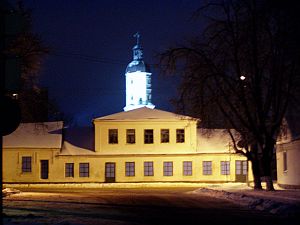
| ||
| City centre of Nyazvizh |
Nyazvizh is definitely one of the best preserved old towns in the Belarus, which can be easily seen in the centre. The town stretches from north to south along a long street, but the northern part of the town is rather new and not very interesting. The main street is called вул. Саветская (Street of the Soviets) - what else - and crosses the central square. The bus terminal is only 10 minutes away from the bus terminal on foot at Soviet street - on the left side when heading north. Right at the central square starts the smaller вул. Ленінская (Lenin Street), leading to the castle. Most attractions of the town concentrate in the small area between the square and the castle. The latter is already out of town, but only 10 minutes away on foot from the square.
History
Nyazvizh was first mentioned during the 13th century, which makes it a comparatively young town, since most other large cities in the Belarus were founded during or before the 11th century. However, the town didn't start booming before the the second half of the 16th century, when the Polish noble family of Radziwiłł (Radzivill) declared Nyazvizh its residency. Between 1584 and 1616, extraordinarily strong fortification systems were constructed by Italian craftsmen. The Radzivills were very influential at that time - one member of the family even became the archduke of →Poznań. The first publishing company of Belarus was founded in 1562 in Nyazvizh - issuing culturally important books.
The town itself became an important trade centre. Several significant buildings such as the castle, Polish churches, a hospital, St. Bernhard, Dominican, Jesuit, Cistercian and other monasteries etc. were built during the 16th and 17th century. In the 18th century, a chapel, a cadett school, a theater and more were added. Unfortunately, the town was destroyed not just once after that. However, compared to other cities in the Belarus it's remarkably well preserved.
Getting there / transportation
The best way to get to Nyazvizh is via Гарадэя (Garadeya), in Russian Городея. Garadeya lies some 15 km north of Nyazvizh on the important Berlin-Moscow-railway. International train do not stop there, but all other trains do. Buses run regularly between Garadeya and Nyazvizh, which takes around 30 minutes and costs 0.5 €. Another option is to share a taxi with the locals, which costs 1 Euro per person when there are 4 passengers. Bus tickets are sold at a counter inside the train station, buses leave from the square in front of the station.
From Garadeya, the Elektrichka (commuter train) runs all the way to →Minsk (2 hrs, 1.2 €), Baranovichi (1 hr, 0.40 €) and even to →Brest (5 hrs, 2.70 €). Note that all international trains stop in Baranovichi.
Garadeya is only 5 km away from the M 1 - the motorway connecting Brest with Moscow. Or Western Europe with Siberia so to say. Therefore, Nyazvizh is also well accessible by car.
One of the architectural gems of Nyazvizh (if not of the Belarus!) is the Фарный костел иезуитов (Farnyi Jesuit church) (whatever 'Farnyi' means - I couldn't find out). The church was constructed by an architect called Bernhardoni between 1584 and 1593. As a matter of fact, this church was the first Jesuit building in Poland. A Jesuit college was attached to the church, but the school closed in 1826. The church was built in early Baroque style.
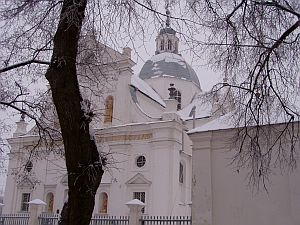
| ||
| The former Jesuit church 'Farnyi' |
Nowadays the church is used by the Catholic community, although only 3,000 out of the 14,000 inhabitants are Catholic (according to the priest; the rest of the population seems to be orthodox). The priest is a very kind man and lucky as a child when he can use English. Although it's forbidden to take pictures inside - at least that's what it says everywhere - the priest told us that we can photograph whatever we want. He offered us to take us around and show as even restricted areas such as the crypt. The altar from the 18th century depicts the Last Supper in a somehow different way. The large crypt is used as the burial place of the Radziwiłł family - actually, the church was once built to be the Radziwill family church. Numerous coffins, not buried but simply standing around, contain the remainings. The last Radziwill was buried there in 1991 (if I got the priest right).
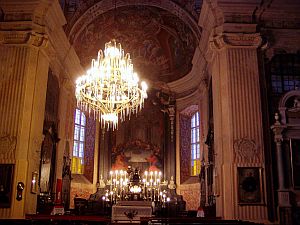
| ||
| Inside the Farnyi Church |
Rather unusual is the way one of the women was buried - here the coffin, there a large jar containing her intestines. In a separate part of the crypt, the coffins of some ten children are laid out. Those children mainly died because of cholera. Entrance to the church is free, but the church is only open when the priest is present (because of the many thieves he said).
Another real jewel is the дворцово - замковый ансамбль (Castle-Palace-Ensemble) - that's at least the translation of the Russian name. It's already out of town but very close. A beautiful alley, sandwiched between two large ponds, leads to the castle. It was built during the 16th century by the above mentioned Bernhardoni for the Radziwill family. However, construction wasn't completed before the 18th century. Among other things, it today houses an important library.
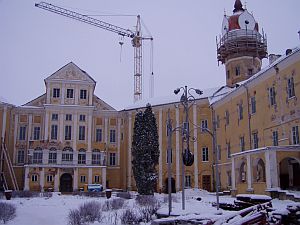
| ||
| The castle - here under construction (2004) |
Unfortunately, the castle was destroyed in 1919 by the advancing Bolsheviki. Later on, the castle was reconstructed half-heartedly to use it as a sanatory. In winter 2004/05, the castle was under construction. According to a large information board at the gate, construction shall be completed in Novemer 2006. One thing is for sure - the castle will be nice after completion. But it was not stated what the castle is going to be used for. There's also a small museum near the entrance (on the other side of the alley), but it was closed when we went there.
It doesn't come as a surprise that there's a monument and an eternal flame dedicated to the victims of the Great Patriotic War (aka WWII) next to the castle. Nevertheless it's a very pleasant place and nice to stroll around.
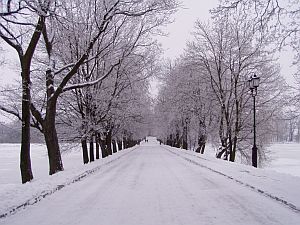
| ||
| Winter scenery in Nyazvizh |
There's plenty more to see - a nice tower and another church, some old wooden and stone buildings, the interesting old city hall in the middle of the central square and some more. Everything is close to each other, so it's easy to explore everything on foot within half a day or so. Nyazvizh is definitely worth a visit since, in contradiction to →Minsk for example, it's possible to experience Belarusian history (and Polish history) here.
Around 30 km further to the north, or to say it very ungeographically, on the other side of Garadeya lies the very small town Мір (Mir), which features a large castle from the 16th century. Unfortunately we hadn't had the time to explore Mir. No problem - the castle can be seen on the back of Belarusian 10,000 Ruble-bills.
The large city of Baranovichi didn't look very promising, so we left it without strolling around. It looks like a large, dull industrial town. But I might be wrong. Attention: There are two large train stations in town, with local trains and international trains stopping at different terminals!
Travelers face three options: Wild camping, driving on or staying at the Гасцініца Нязвіж (Gastsinitsa Nyazvizh). The only hotel in town can be found at the central square behind the old city hall in a grey, unspectacular building. Foreigners pay 13 Euro per person in a double room - with own bathroom and hot water. Staff is quite nice. There's a small cafe in the first floor, but they seem to open and close the place very spontaneously. The hotel also houses the only real restaurant in town, which turns into a disco late at night. The food is average but plentiful and prices are normal (which means a sufficient supper with starter, dessert and some drinks costs some 4 Euro). Address: vul. Belaruskaya 9 (note that no one seems to know this name! Just ask for THE hotel). Tel.: 01770-553 67
The official website of Nyazvizh seemed to have vanished! Here are other resources:
- b4w.narod.ru/nesvizh/: Very useful website about Nyazvizh incl. city map, nice descriptions of all sights and pictures. Unfortunately in Russian only.
- www.rikscha-tours.de: Personal travelogue from a brave cyclist who also visited Nyazvizh. Fun to read, but in German only.
Do you have or do you know a good website about Nyazvizh? Don't hesitate, let me know! After checking it, I would love to add it to the link list. You can submit a link by using the →contact form. Note that commercial websites will be treated differently.
©2024 Europe-East.com

 Albania
Albania Belarus
Belarus